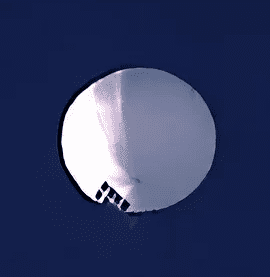By Cara Mico, Assistant Editor
If you’ve been paying attention to sky-news, you’ve likely heard about the balloon incidents. While unlikely to cause more international drama, it has made many curious about what these balloons and other objects are doing. Headquartered in Tillamook County is Near Space Corporation whose specialty is high altitude research balloons. We asked local balloon expert Eric Waters from Near Space Corporation (NSC) to provide some insight in terms of what the balloon’s purpose may have been and have put together a brief history of balloons and the research and military uses.
CNN reported that “the US is confident that what they shot down is, in fact, a spy balloon, disclosing that the balloon carries surveillance equipment not normally associated with civilian research, with collection pod equipment and solar panels.”
When questioned, a Chinese official claimed that the balloon, as well as a second balloon spotted over Latin America, was a civilian airship that “mistakenly drifted into the region.”
John Kirby, a spokesperson for the National Security Council, told journalists that several objects were shot down in the past weeks over Alaska (not a balloon, concerningly octagonal with an unclear method of suspension and a bunch of cables hanging from it… not at all ominous), North Carolina, and Montana. A balloon was also shot down over Columbia.
Mr. Waters of NSC was cautious about speculating, but he provided a solid background as to how these balloons work and how they might have drifted to a specific area. The type of balloon shot down over Montana was similar to those used in NSC operations. For more information about NSC read a recent article here.
“Ours are inflated with helium, can carry anywhere from 10 pounds to 2 tons up to the stratosphere,” said Mr. Waters, explaining that these balloons travel at mach zero, and, to some extent, pilots can only control the altitude without more complex guidance systems in place, He continued, “We use the different winds at different altitudes to control direction. The idea of station keeping, winds are always moving and the balloon can’t stay in one place. Some balloons have lead ballast they release to maintain a stationary orbit.”
In order to stay in place for a long period of time, the pilot or controller must account for wind speed and direction changes from the diurnal cycle, where temperature and pressure changes result in losing lifting capability. How exactly would a controller steer the balloon so far from its launch site?
“Sat-comms are likely the only way to communicate at that distance,” added Mr. Waters, “we use line-of-sight radio for our communications.”
So without some type of navigation, it would be “very lucky to get it in the same time zone or state, but it’s difficult to navigate a balloon to a specific place,” added Mr. Waters.
It’s extremely unlikely that either China or the US will engage in the type of balloon warfare of eras gone by anytime in the near future, as both countries have vested interests in keeping the peace.
The President ordered the balloon be taken down after ensuring that any falling debris wouldn’t harm civilians, a move which China later condemned, going so far as accusing the US of repeatedly sending spy balloons into Chinese controlled airspace. For a timeline of the balloon’s journey go here.
For more about Near Space Corporation, go to https://nsc.aero/


